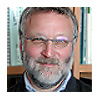Allan Basbaum, PhD, professor and chair of the Department of Anatomy at UCSF, was elected to the Royal Society, the UK's national academy of science, on May 18.
Basbaum is distinguished for his pioneering observations in pain research. He has demonstrated a critical contribution of the nervous system to inflammatory disease and, using genetic approaches to analyze molecules that underlie the development of chronic pain, has identified several new therapeutic targets for its treatment.
Founded in 1660, the
Royal Society supports many top scientists, engineers and technologists, influences science policy and debates scientific issues. An independent, scientific academy, the society derives its authoritative status from its 1,400 fellows and foreign members.
The process of election to the society is extremely rigorous and is based on the scientific system of peer review. Fellows are elected for their contributions to science, both in fundamental research resulting in greater understanding, and in leading and directing scientific and technological progress in industry and research.
Basbaum and other new fellows will be formally admitted to the society at the Admissions Day ceremony in July.
See official announcement here.
"To my knowledge, there are only two pain researchers who have been elected to the Royal Society," Basbaum said. "One of them is my mentor, Patrick Wall, who died several years ago. It is an incredible honor to be in his company and to know that people from outside of the pain research universe are recognizing the contributions of my laboratory."
Basbaum's research interests concern the transmission and control of pain-stimulating messages and the molecular mechanisms that contribute to persistent pain in tissue or nerve injury. He and his colleagues have identified proteins on the surface of many sensory nerves that trigger the nerves to fire pain signals under certain conditions.
Recently, Basbaum was part of a team of UCSF scientists that made a critical discovery that may help in the development of techniques to promote functional recovery after a spinal cord injury. By stimulating nerve cells in laboratory rats at the time of the injury and then again one week later, the scientists were able to increase the growth capacity of nerve cells and to sustain that capacity. Both factors are critical for nerve regeneration.
That study, reported in the Nov. 15, 2005 issue of the
Proceedings of the National Academy of Sciences, builds on earlier findings in which the researchers were able to induce cell growth by manipulating the nervous system before a spinal cord injury, but not after.
Read UCSF news release here.
Basbaum, along with Howard Fields, MD, Endowed Chair in Pharmacology of Addiction in Neurology and director of the Wheeler Center for the Neurobiology of Addiction at UCSF, also discovered an endogenous pain control network that underlies the analgesia produced by both opiates and electrical brain stimulation, and showed that this analgesia results from inhibition of spinal cord pain transmission neurons.
His studies of the deafferented spinal cord with the late Patrick Wall, DM, FRS, a professor of physiology at St. Thomas's Hospital Medical School, London, established the first animal model of nerve injury-induced neuropathic pain and demonstrated a remarkable plasticity of somatotopic maps, an observation that inspired numerous studies of injury and use-dependent reorganization in the somatosensory system.
Some of his studies with Jon Levine, MD, PhD, professor of medicine and oral and maxillofacial surgery, also demonstrated a critical contribution of the nervous system to inflammatory disease. Using genetic approaches, Basbaum and colleagues, including David Julius, PhD, professor and vice chair of the Department of Cellular and Molecular Pharmacology, have identified and characterized a variety of molecules that underlie the development of chronic pain, several of which may be future therapeutic targets.
Basbaum was elected to the Institute of Medicine in 2005 and the American Academy of Arts and Sciences in 2003. In 2001, he was part of the first class selected for the UCSF Haile T. Debas Academy of Medical Educators, which helps shape advances in medical curricula.
"The new curriculum has illustrated the importance of integrating basic and clinical sciences in medical education," Basbaum said. "I was actively involved when the curriculum was restructured, and worked to ensure that cutting-edge science was not cut out of the curriculum, despite the significant reduction in lecture hours."
Asked what more he would like to accomplish in his career, Basbaum said, "Contribute to the development of a new drug that will replace some of the existing ones used to control chronic pain."

